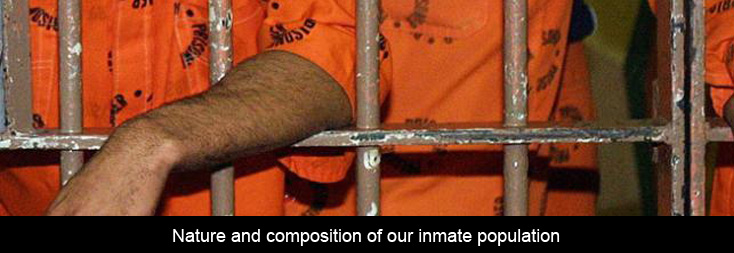What is the nature and composition of our inmate population?

The Minister of Correctional Services has provided insights to the nature and composition of our inmate population in an address delivered to Parliament. We would like to share this:
Remarks by Minister, Mr. Sibusiso Ndebele, MP
Portfolio Committee, Parliament, Cape Town
7 August 2012
My deployment as Minister of Correctional Services has led me to reflect on our experiences as prisoners on Robben Island, and recommit myself to ensuring that some of what we experienced during that time will never be experienced by inmates in correctional centres in a democratic South Africa. It has also led me to reflect on the basic principles of the vision of the criminal justice system reflected in the Freedom Charter, worth repeating as food for thought and a yardstick of how far we have come:
ALL SHALL BE EQUAL BEFORE THE LAW!
No one shall be imprisoned, deported or restricted without a fair trial;
No one shall be condemned by the order of any government official;
The courts shall be representative of all the people;
Imprisonment shall be only for serious crimes against the people, and shall aim at re-education, not vengeance;
The police force and army shall be open to all on an equal basis and shall be the helpers and protectors of the people;
All laws which discriminate on grounds of race, colour or belief shall be repealed.
Against this, we can both salute achievements and identify areas where we have still a long road to travel to ensure that the White Paper is fully embedded in society.
I have led departmental events, observed the department in action, participated in international work on correctional matters and overseen critical policies being implemented. I have not at this stage been able to take in-depth briefings from all the managers in the Department, but have not found them wanting in relation to the provision of information that I have needed so far.
I have taken note of the nature and composition of our inmate population, and this must inform our work. Rounded off figures give us an important picture:
23% of offenders are sentenced for economic offences;
55% of offenders are sentenced for aggressive crime;
16% of offenders are sentenced for sexual offences;
2% of offenders are sentenced for drug related crime; and
5% of offenders are sentenced for other crimes.
About 71% of offenders are incarcerated for violent crime, supporting the public perception that South Africa is not safe and is violent. There is a need to strengthen and reinforce the programmes to address aggressive crimes. Nearly a quarter of offenders are sentenced for economic crimes.
The fact that we have approximately 40% of inmates who are remand detainees must also factor into our resource allocation and our strategic focus. The average number of remand detainees in 2011/12 was approximately 46,000, and the average number of sentenced offenders for the same period was approximately 113,000. Last year, there were over 10,000 offenders serving sentences of incarceration for periods less than 2 years. It is significant to note that about 2,500 of these were sentenced for aggressive offences, just over 5,000 for economic offences, about 1,000 for narcotics related offences, just over 100 for sexual offences and about 1,700 for other offences. In addition, we have approximately 19,500 probationers and about 42,000 parolees in the community corrections system.
Although it is not easy to get current and accurate information, using the latest information available from the International Centre for Prison Studies as a yardstick, South Africa has by far the largest inmate population in Africa (approximately 146,000), followed by Ethiopia, in the region of 85,000 inmates. Egypt, Rwanda and Morocco come next in the 60,000s. I have been amazed to learn that Nigeria, with a prison population of about 40,000, has one third of the number of inmates that we incarcerate in South Africa, and has an incarceration rate of 31 inmates per 100,000 people in the country. South Africa is about 18th on the world list of incarceration rates, and in Africa seem to have even overtaken Botswana in the last couple of years – we incarcerate about 316 people out of every 100,000 citizens. In comparison, USA has the highest incarceration rate of 743 people out of 100,000, and Russia the second highest has 568 people inside out of every 100,000. In reflecting on what this means, we need to take into account the violent nature of crime in South Africa; we need to recognise that the attitude that incarceration is the best crime deterrent is still prevalent in our judiciary; but these facts require us to think deeply about the manner in which we approach incarceration in this country.
Women inmates comprise just over 3% of the inmate population, but it is significant that over the past three years, there was a slight increase in the female inmate population, reaching to 3,758 in 2011/12. We must continue to create conditions conducive for the rehabilitation of women offenders, the mother and baby units and facilities designed for women inmates, and offender labour and skills development for women offenders will be sustained. However, we must also ensure that we focus on the vast bulk of inmates – young Black men. The White Paper on Corrections in South Africa (2005) defines “youth” as a person between the ages of 18-25 years. This definition is customized to the service environment of the Department of Correctional Services, and is in line with the Correctional Services Act (Act No 111) of 1998 and the UN Standard Minimum Rules. We have approximately 53,000 youth in our remand detention facilities and correctional centres, and a large number of inmates who while not under 25 are still in the prime of their life.
We should also note that about 40% of offenders are serving sentences over 10 years, approximately 10 000 of whom are lifers. It is of concern that there is an increase in offenders sentenced to life imprisonment.
Let me reflect briefly on some of the activities that I have been involved in:
Visit to Durban Westville facility as orientation;
Process on first 12 offenders applications for medical parole;
Madiba Day activities at Tsakane School;
Closure of remission process;
Attended the SADC Organ on Politics, Defence and Security meeting;
Launch of women’s month; and
Initiation Reading For Redemption campaign.
The contribution of Correctional Services to the building of a peaceful, secure and democratic society is in my view very much under-valued. We have a big responsibility to educate the public on the importance of rehabilitation in creating the South Africa we envisage – safe for all people, in particular women and children. The Department has three Core Functions: to contribute to enhanced public safety and effective criminal justice through effective management of remand detention; to contribute to reduced re-offending through offender management and rehabilitation interventions for incarcerated offenders; and to contribute to social reintegration of offenders through management of non-custodial sentences and parole. Correctional centres must be places not for locking people up and throwing away the key; not for letting offenders rot in cells; but places where offenders have to face up to what they have done to victims, have to engage with restorative justice processes; have to complete corrections and development programmes; where offenders are involved in production workshops; bakeries; farming and return to the community with skills. When the cell is locked behind an inmate, he or she has nowhere else to turn, but to focus their eyes on the way out of that cell – not through escapes, but through breaking the cycle of crime and reintegrating into the community.
We have said since 2005 that corrections is a societal responsibility – and building on that, our vision is of a trilogy of offenders, victims and the community in partnership with each other and with the Department to break the cycle of crime. This trilogy underpins the moulding of a new person against all the odds that a life of crime has thrown at them, and there can be no sustainable rehabilitation and reintegration back into the society outside of the trilogy of offender, victim and the community. Correctional Services is the last hope for victims of crime and for many of the individuals sentenced for crime. All offenders, except for lifers who are considered inappropriate for parole, return to society at the end of the sentences. It is our responsibility to ensure that they are in the best state to be constructive members of society on their release.
We must build a Department appropriately geared for delivery on the White Paper on Corrections and the draft White Paper on Remand Detention and with good governance, high level of compliance, and tight system of management, appropriate resourcing and tight resource management and accountability. In relation to service delivery our goal is see deliberate improvement in:
the reduction of the time spent in remand detention and improvement in the conditions of remand detention;
the improvement in delivery of rehabilitation programmes (corrections programmes and development programmes) to offenders;
the involvement of offenders in offender labour in workshops, bakeries, and farms; and
the improved use of non-custodial sentences and supervision and management of probationers and parolees.
STRATEGY INHIBITORS
I have been briefed by the management of the Department on the broad sweep of the draft Annual Report on 2011/12, the achievements in relation to service delivery to remand detainees, incarcerated offenders, probationers and parolees, and on the six critical challenges that must be addressed to enable the Department to deliver on its mandate effectively. It is our view that these strategic inhibitors must be addressed in the short term to enable effective and enhanced delivery over the medium term. The six strategy inhibitors (and I note that these issues have received focused attention of the Portfolio Committee over the past years) that we will turn around are:
Overcrowding;
Structural dysfunctionality, manner of implementation of the OSD, inappropriate shift system, and staff shortages;
Inadequately designed and maintained facilities;
Inadequate ICT infrastructure, hardware and information systems;
Consistent underspending of the voted funds and misalignment of budget allocations; and
Inadequate management of performance information, planning and performance reporting.
I will be ensuring accountability of the managers in relation to these six areas and I look forward to a partnership with the Portfolio Committee on this journey.
IMPROVING IMPLEMENTATION OF THE WHITE PAPER
While we have to address the challenges that underpin and hamper service delivery of the Department, we need to deliberately focus on important elements of the White Paper on Corrections that have not been adequately embedded in the fabric of the Department.
The development of corrections programmes for all crime categories and offence based involvement of offenders in these programmes is the essence of our mandate. The White Paper requires that all offenders should undergo corrections programmes specific to the crimes for which they have been sentenced. In this regard we have two areas of focus – firstly to ensure that offenders are properly rostered into the existing correctional programmes in accordance with their correctional sentence plans; and secondly that the Department develops in partnership with external expertise where necessary appropriate corrections programmes for the range of crime categories. We still face the task of implementing the refined crime category system – moving from 5 crime categories (aggressive, sexual, economic, narcotics and other) which do not assist with offence based interventions to the 21 crime categories that have been identified as being the key rehabilitation focus areas going forward. We want to see restorative justice integrated into the corrections interventions – the value of corrections programmes without restoration of the relationship between the offender, the victim and the community is of reduced value, and will not break the cycle of crime in a sustainable manner.
The uniqueness of Correctional Services amongst other government departments is that we have a range of professional services to provide and have the responsibility to have the staff, or the partners to be able to assist the offender in an appropriate manner. Improved offender involvement in development programmes and in productive offender labour is an important part of assisting the offender. Our plans focus quite strongly on the improvement of offender involvement in education and skills development programmes and the necessary human resourcing and partnerships to enable the Department to deliver on this must be prioritised. We must build on the 8 accredited schools, and strive to obtain a 100% matric pass rate. At the end of last financial year, 65% of eligible offenders had access to adult education. My background and my experience of years in prison has led me to evaluate the state of the libraries in our correctional centres. My vision of Reading for Redemption is based on the understanding that reading builds character and instills a culture of learning and growth. My aim that our book stock should match at least our offender numbers has caused me to issue a call for the community to come to the party by donating books to the Department. The resourcing of resource centres and libraries will be receiving our personal attention.
Key to rehabilitation is empowering offenders to have skills to function effectively in society on their release, but equally important is to ensure that offenders are actively involved in productive activity while they serve their sentences. We want to see offenders proudly contributing to their self-care. In the planning process for the next MTEF period this will be an area in which I will ensure there are clear and resourced targets set. I am encouraged by the initiative that the department has taken towards establishing a trading entity, which will impact positively on utilisation of offender labour. But this in itself will bring another challenge to the fore – how can we improve the scope for offenders on their return to society to be productive members of the community? To this end, I intend to enter into dialogue with the private sector to establish what I call after-care centres – centres for parolees and ex-offenders where they are able to be involved in productive labour. We need, and will have, a seminar with business leaders and key stakeholders on how we can address the stigma that makes the reintegration of offenders into the community such a difficult process for offenders and an onerous task for the department. Again the trilogy of offender, victim and community must come to the fore.
Public education about the system of parole, the basis for parole decision making, and the system of parole supervision including electronic monitoring must be a shared responsibility. It is a very misunderstood system – as has been witnessed in some commentary on the release of Mr. Selebi on medical parole. The initiative of piloting Halfway Houses to enable those ready for being paroled, but without monitorable addresses, to find their place in the community must be thoroughly evaluated, resourced and taken forward in an appropriate manner. For the offenders who have served long sentences in our facilities, the system of day parole must be enhanced. While our policy allows for day parole, and indeed we are using it to prepare long term offenders for moving back into the community, the resourcing of day parole is extremely uneven and must be appropriately capacitated.
The South African incarceration rate and the 10-12 thousand offenders sentenced to incarceration for less than 24 months, has focused my attention on the need for better use of non-custodial sentences as the rehabilitation path for offenders guilty of lesser crimes and improved management and capacity of community corrections. The Department has in the White Paper on Corrections and in the discussion document on social reintegration conceptualised an important role for community corrections, but we have not yet structured and resourced this component correctly. We must avoid conflating community corrections with parole. As much as we must improve the management of parole, we must focus on community corrections as a direct non-custodial sentence opportunity and convince the judiciary that this is indeed a more appropriate sentence than incarceration for short term offenders. To this end, we have determined that we will, during this year, convene a dialogue with stakeholders, including yourselves as Portfolio Committee, to develop a strategy to reduce the incarceration rate in South Africa. The establishment of the Branch Community Corrections in DCS is an important step towards the operationalising of the position paper on social reintegration and the White Paper on Corrections. Major attention and resources needs to be focused on the system of non-custodial sentences (probation) if the policy position mapped out in the White Paper and in the discussion document on social reintegration is to be achieved.
Our focus is on the corrections system and breaking the cycle of crime, but I am very cognisant of the fact that our work begins earlier on in the criminal justice system, with remand detention. This has been the delegated responsibility of the Deputy Minister, and I intend to continue to rely on his expertise in this regard. However, let me be clear that the enhancement of the system of remand detention management in practice is a government and departmental priority. The progress made in separating the system of management of Remand Detainees from the system of management of sentenced offenders will further contribute to the advancement of this agenda; however we must note that this is only in its infancy and it will have resource implications, financial, human, ICT and infrastructural that will have to be appropriately costed and budgeted for. I am concerned that we do not lose sight of the vision of remand detention as a distinct function from corrections, and look forward to consultation with key stakeholders on the draft White Paper in the near future, before we take the document to Cabinet and then to Parliament.
It is clear to me as I start on this journey with Correctional Services, that active promotion of remand detention, of corrections incarceration, and of community corrections matters within the JCPS Cluster is critical to ensuring that South Africa has the criminal justice system that its people deserve. I would encourage close partnerships between the cluster portfolio committees.
I look forward to a close and dynamic partnership with Portfolio Committee. The complexity of this department and the number of areas that require oversight means that we should be clear of the roles of various oversight mechanisms. For example, conditions of detention and complaints of inmates is the purview of the Inspecting Judge and an elaborate system and capacity has been put in place to manage this. The Portfolio Committee is encouraged to rely on the Inspecting Judge’s interaction with the Department on such operational matters. The Portfolio Committee focus on the administrative and financial delivery and reporting is well appreciated and its impact in the Department is visible. My staff recently joined you on your oversight visit and have provided me with feedback on the issues you are concerned about. The National Commissioner and the Chief Operations Officer will be focusing on addressing issues raised in your oversight reports.
The importance of accountability of management, be it to the Minister, Portfolio Committee and other Parliamentary Committees, to international bodies, and ultimately to the public of South Africa cannot be over-emphasised.



